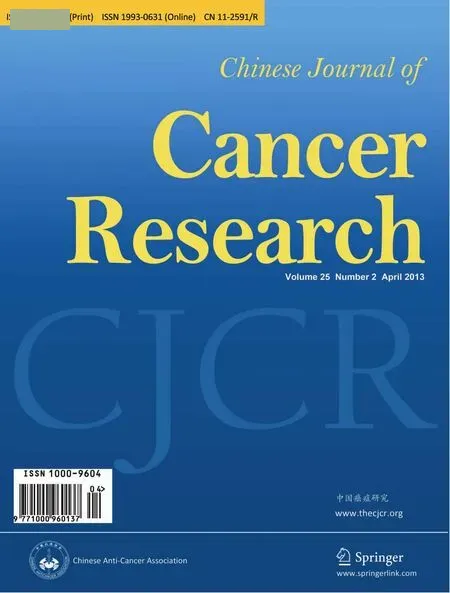Safety and efficacy of trimodality therapy in patients undergoing extrapleural pneumonectomy
Department of Thoracic Surgery, Dr.-Horst-Schmidt-Klinik, Ludwig-Erhard-Strasse 100, 65199 Wiesbaden, Germany
Safety and efficacy of trimodality therapy in patients undergoing extrapleural pneumonectomy
Servet B?lükbas
Department of Thoracic Surgery, Dr.-Horst-Schmidt-Klinik, Ludwig-Erhard-Strasse 100, 65199 Wiesbaden, Germany
Corresponding to:Servet B?lükbas, MD, PhD, FETCS. Department of Thoracic Surgery, Dr.-Horst-Schmidt-Klinik, Ludwig-Erhard-Strasse 100, 65199 Wiesbaden, Germany. Email: Dr.Bolukbas@gmx.de.

Submitted Jan 19, 2013. Accepted for publication Feb 19, 2013.
Scan to your mobile device or view this article at:http://www.thecjcr.org/article/view/1510/2471
Malignant pleural mesothelioma (MPM) is a rare but rapidly deadly disease (1). Macroscopic complete resection (MCR) is the goal of surgery (2). MCR seems to have the most significant impact on survival in patients undergoing multimodality treatment for MPM. The role of surgical resection in the management of MPM remains controversial. The selection criterion to perform either extrapleural pneumonectomy (EPP) or extended/radical pleurectomy/ decortication (PD) rely not only on the cardio-pulmonary status of the patient, tumor stage and intraoperative findings but is strongly dependent also on surgeons’ decision and philosophy. This is reflected by a recent survey of opinions and beliefs among 802 thoracic surgeons, in which EPP was believed to be more effective than PD (3). Nonetheless, either surgery might achieve MCR.
There is no evidence-based consensus about the treatment of MPM due to its rarity and the lack of large prospective randomized trials in multicenter settings. Therefore, the authors have to be congratulated for a concise, succint and very informative systematic review with regard to trimodality therapy (TMT) involving EPP with neoadjuvant or adjuvant chemotherapy and adjuvant radiotherapy (4). Primarily, the authors assessed the safety and efficacy of TMT in patients undergoing EPP as surgical treatment modality.
EPP is the most aggressive surgical procedure. It involves the en bloc resection of the visceral and parietal pleura, lung, pericardium, and diaphragm. Complex surgical procedures come with mortality and morbidity, respectively. In this systematic review, mortality and morbidity ranged between 0-12.5% and 50-82.5%, respectively. However, complications of surgery may cause delay or refusal of chemotherapy and/or radiation which might be linked directly to inferior outcomes in terms of survival. This is reflected by the fact that only approximately 50-60% of the patients completed the TMT in recent large prospective studies (5,6). As recommended by the NCCN Guidelines, EPP should be performed by board certified thoracic surgeons on highly selected patients (7). Thus, surgical expertise and patient selection play a major role to define EPP as a safe procedure.
Recurrence of disease occurs locally and distantly irrespective of the aggressiveness of surgery. The present study demonstrated that treatment failure in terms of overall disease recurrence was as high as up to 84%. The progression-free-survival ranged between 10.1 and 16.3 months. There is no doubt about the recurrence of disease irrespective of the aggressiveness of surgery. But further treatment options after EPP remain difficult. In case of recurrence only about 25% of the patients receive additional chemotherapy after EPP and TMT (5). Generally, approximately 85% of the patients die within the first 3 months in event of recurrence (8). On the other hand, EPP is associated with prolonged survival. Overall median survival ranged from 12.8-46.9 months. Nonsurgical treatment options have to be compared to EPP outcomes. Best supportive care as the baseline therapy results in overall survival of 4.5 months, whereas early palliative chemotherapy is associated with overall survival of 14 months (9). Chemoradiation using the pleural IMRT technique results in promising median survival of 17 months (10). Thus, the role EPP within TMT remains controversial with regard to the efficacy of EPP but EPP offers long-term survival in highly selected patients.
The take home message of this systematic reviewis that EPP within TMT is associated with acceptable perioperative outcomes and long-term survival in highly selected patients treated in specialized centers. But, the philosophy of limiting the surgery related morbidity and mortality as well as maintaining physiological reserve, while overall not compromising the oncological aggressiveness, might be a key component of long-term survival for MPM patients. There are several multimodality treatment studies using lung-sparing PD (11-13). These studies were associated with safety and efficacy as well. Lung-sparing procedures lead to significant improvement of pulmonary function and quality of life (14,15). Maybe less could be more for MPM patients. I hope that Cao and colleagues investigate the safety and efficacy of lung-sparing PD within multimodality treatments in a forthcoming systematic review.
Acknowledgements
Disclosure:The author declares no conflict of interest.
1. Robinson BW, Lake RA. Advances in malignant mesothelioma. N Engl J Med 2005;353:1591-603.
2. Sugarbaker DJ. Macroscopic complete resection: the goal of primary surgery in multimodality therapy for pleural mesothelioma. J Thorac Oncol 2006;1:175-6.
3. Treasure T, Internullo E, Fiorentino F, et al. A survey of opinions and beliefs concerning surgery for malignant pleural mesothelioma amongst 802 members of the European Association for Cardio-Thoracic Surgery (EACTS), the European Society of Thoracic Surgeons (ESTS) and the Society of Thoracic Surgeons (STS). Interact Cardiovasc Thorac Surg 2011;12:341-6.
4. Cao C, Tian D, Manganas C, et al. Systematic review of trimodality therapy for patients with malignant pleural mesothelioma. Ann Cardiothorac Surg 2012;1:428-37.
5. de Perrot M, Feld R, Cho BC, et al. Trimodality therapy with induction chemotherapy followed by extrapleural pneumonectomy and adjuvant high-dose hemithoracic radiation for malignant pleural mesothelioma. J Clin Oncol 2009;27:1413-8.
6. Weder W, Stahel RA, Bernhard J, et al. Multicenter trial of neo-adjuvant chemotherapy followed by extrapleural pneumonectomy in malignant pleural mesothelioma. Ann Oncol 2007;18:1196-202.
7. Available online: http://www.nccn.org/professionals/ physician_gls/pdf/mpm.pdf
8. Baldini EH, Recht A, Strauss GM, et al. Patterns of failure after trimodality therapy for malignant pleural mesothelioma. Ann Thorac Surg 1997;63:334-8.
9. Zahid I, Sharif S, Routledge T, et al. Is pleurectomy and decortication superior to palliative care in the treatment of malignant pleural mesothelioma? Interact Cardiovasc Thorac Surg 2011;12:812-7.
10. Rosenzweig KE, Zauderer MG, Laser B, et al. Pleural intensity-modulated radiotherapy for malignant pleural mesothelioma. Int J Radiat Oncol Biol Phys 2012;83:1278-83.
11. B?lükbas S, Manegold C, Eberlein M, et al. Survival after trimodality therapy for malignant pleural mesothelioma: Radical Pleurectomy, chemotherapy with Cisplatin/ Pemetrexed and radiotherapy. Lung Cancer 2011;71:75-81.
12. Friedberg JS, Culligan MJ, Mick R, et al. Radical pleurectomy and intraoperative photodynamic therapy for malignant pleural mesothelioma. Ann Thorac Surg 2012;93:1658-65; discussion 1665-7.
13. Lang-Lazdunski L, Bille A, Lal R, et al. Pleurectomy/ decortication is superior to extrapleural pneumonectomy in the multimodality management of patients with malignant pleural mesothelioma. J Thorac Oncol 2012;7:737-43.
14. B?lükbas S, Eberlein M, Schirren J. Prospective study on functional results after lung-sparing radical pleurectomy in the management of malignant pleural mesothelioma. J Thorac Oncol 2012;7:900-5.
15. Mollberg NM, Vigneswaran Y, Kindler HL, et al. Quality of life after radical pleurectomy decortication for malignant pleural mesothelioma. Ann Thorac Surg 2012;94:1086-92.
Cite this article as:B?lükbas S. Safety and efficacy of trimodality therapy in patients undergoing extrapleural pneumonectomy. Chin J Cancer Res 2013;25(2):130-131. doi: 10.3978/j.issn.1000-9604.2013.02.04
10.3978/j.issn.1000-9604.2013.02.04
 Chinese Journal of Cancer Research2013年2期
Chinese Journal of Cancer Research2013年2期
- Chinese Journal of Cancer Research的其它文章
- Treatment of mesothelioma: still a long way to go!
- Role of contrast-enhanced ultrasonography in percutaneous radiofrequency ablation of liver metastases and efficacy evaluation
- Determining the optimal time for bortezomib-based induction chemotherapy followed by autologous hematopoietic stem cell transplant in the treatment of multiple myeloma
- Bevacizumab rescue therapy extends the survival in patients with recurrent malignant glioma
- Bortezomib, dexamethasone plus thalidomide for treatment of newly diagnosed multiple myeloma patients with or without renal impairment
- Giant neurogenic tumors of mediastinum: report of two cases and literature review
